The Bay Trail Preview: Intel Atom Z3770 Tested
by Anand Lal Shimpi & Brian Klug on September 11, 2013 12:00 PM EST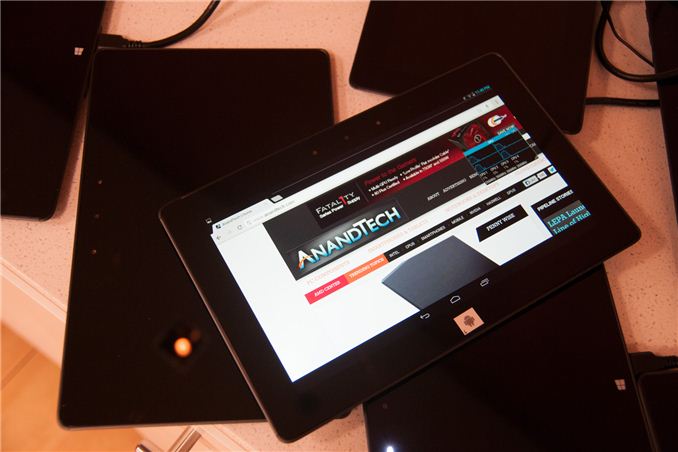
Earlier this year Intel unveiled Silvermont, its first true architectural update to Atom since its introduction in 2008. I won’t rehash Silvermont’s architecture here, but it’s designed to be a true test of Intel’s performance in the ultra mobile space. Leveraging Intel’s first 22nm SoC process and a very low power/efficient microarchitecture, Silvermont aims squarely at the latest Krait cores from Qualcomm and ARM’s Cortex A15.
Today Intel takes the next step forward, introducing the first tablet SoC based on Silvermont: Bay Trail.
Bay Trail takes up to four Silvermont cores, and for the first time in an ultra mobile Intel SoC pairs them with Intel’s own graphics IP. That’s right, rather than using a GPU block from Imagination Technologies, Bay Trail leverages the same GPU architecture as Ivy Bridge.
The first Bay Trail tablets will be shipping by the end of the year, across both Android and Windows 8.1. Intel expects Bay Trail to show up in tablets and 2-in-1s priced below $599, with everything above $599 falling under Haswell’s jurisdiction.
Bay Trail & Branding
Bay Trail, like all Atom platforms before it, will be available in multiple form factors. Unlike the Atoms of yesterday however, the SoC will carry Pentium and Celeron branding when used in notebooks and desktops. Intel didn’t disclose too much about its Silvermont plans in other form factors other than some basic naming:
Basically notebooks ship under the Pentium N3000 & Celeron N2000 series, while desktops will carry Pentium J2000 & Celeron J1000 branding. All Pentium SKUs seem to be quad-core, while Celeron SKUs will be available in both dual and quad-core versions.
Thankfully Intel shied away from introducing the same complexity with its tablet focused Bay Trail parts. All Bay Trail tablet SKUs carry Atom branding. There’s the quad-core Z3700 series and the dual-core Z3600 series.
Although Intel offers both dual and quad-core Bay Trail SKUs, they are both based on the same single physical design. In other words, dual-core Bay Trail parts are just die harvested quad-core parts. Intel isn’t disclosing die size or transistor counts, which is ironic (and disappointing) given that Apple just disclosed both (or at least relative magnitude of one) for its A7 SoC.
Internally, the Bay Trail design is pretty nice. There are either two or four cores enabled, each pair with a shared 1MB L2 cache (2MB total for a quad-core part). Intel is following the unfortunate lead of everyone else in the mobile industry and advertising max turbo frequencies exclusively.
Thankfully Intel hasn’t yet decided to obfuscate max non-turbo frequencies:
| Bay Trail Turbo Speeds | ||||||||
| Z3770 | Z3770D | Z3740 | Z3740D | Z3680 | Z3680D | |||
| Max turbo frequency | 2.39GHz | 2.41GHz | 1.86GHz | 1.83GHz | 2.0GHz | 2.0GHz | ||
| Max non-turbo Frequency | 1.46GHz | 1.5GHz | 1.33GHz | 1.33GHz | 1.33GHz | 1.33GHz | ||
In general you’re looking at 1.33GHz - 1.46GHz max non-turbo frequencies, with Bay Trail being able to turbo up to anywhere between 1.83GHz and 2.40GHz depending on SKU.
Although the core architecture is 64-bit in design, there will be no OS support for 64-bit Bay Trail at launch. Windows 8.1 with Connected Standby appears to still be 32-bit only, and obviously Android is 32-bit only at this point as well.
The memory interface is fairly ridiculous by mobile standards. You either get two 64-bit LPDDR3 channels (128-bit total width) or a single 64-bit DDR3L channel. In the case of the former, that’s the same memory bus width as Apple’s A5X/A6X line of SoCs as well as the standard Core i3/i5/i7 parts. Max supported memory frequency is 1066MHz in dual-channel LPDDR3 mode, or 1333MHz in single-channel DDR3L mode. The only benefit to the latter is really cost, as Bay Trail will purportedly show up in some very cheap devices.
The GPU is Intel’s own Gen7 graphics core, a cut down implementation of what we first saw in Ivy Bridge. I suppose it’s premature to expect Merrifield, Bay Trail’s smartphone counterpart, to also use Intel’s own graphics core but it’s clear this is the direction Intel is headed in - and away from licensing IP from Imagination Technologies.
Rather than 16 EUs in the Ivy Bridge GT2 configuration (HD 4000), Bay Trail’s HD Graphics core ships with 4. The 4 EUs are otherwise effectively identical to what we found in Ivy Bridge. The GPU can dynamically scale frequency and share power between itself and the CPU cores. Minimum GPU frequency on Bay Trail is 311MHz and a max GPU frequency of 667MHz (or 688MHz for the DDR3L SKUs).
Intel is quick to point out that Bay Trail’s GPU supports DirectX 11 and OpenGL ES 3.0. Unfortunately this support list appears limited to Windows. Under Android, it’s unclear whether or not Bay Trail will ship with anything above OpenGL ES 2.0 support. The same goes for GPU accelerated Renderscript. Bay Trail supports up to 2560 x 1440 displays over eDP1.3/DP1.2, or 1080p over HDMI. Panel Self Refresh is also supported.
Video encode and decode blocks also shifted away from Imagination in Bay Trail. Both IP blocks are custom from Intel now. The ISP (Image Signal Processor) is from Silicon Hive (an Intel acquisition).


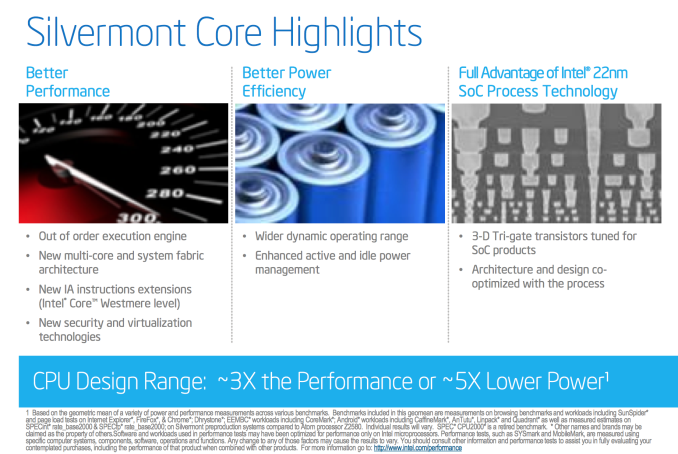
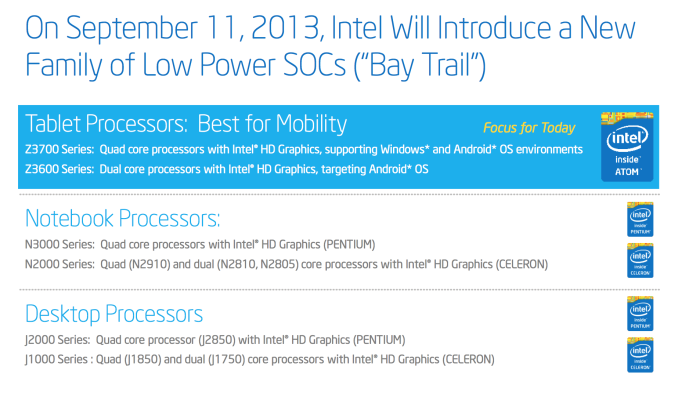
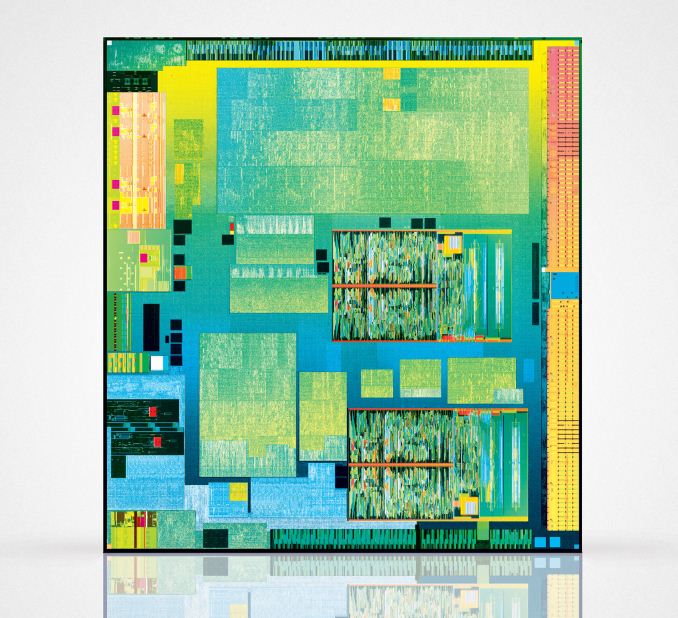
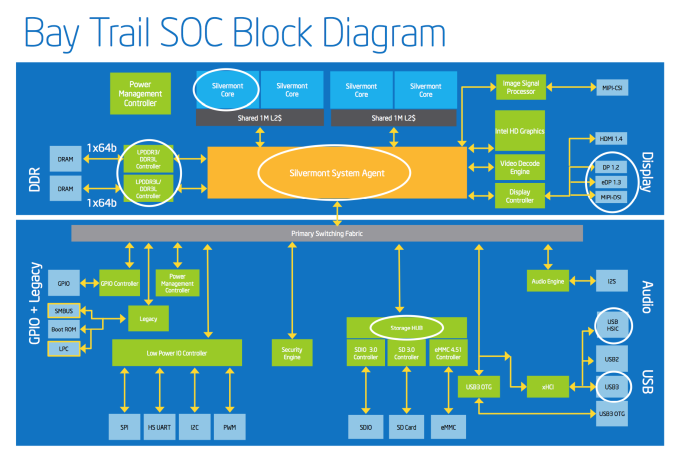
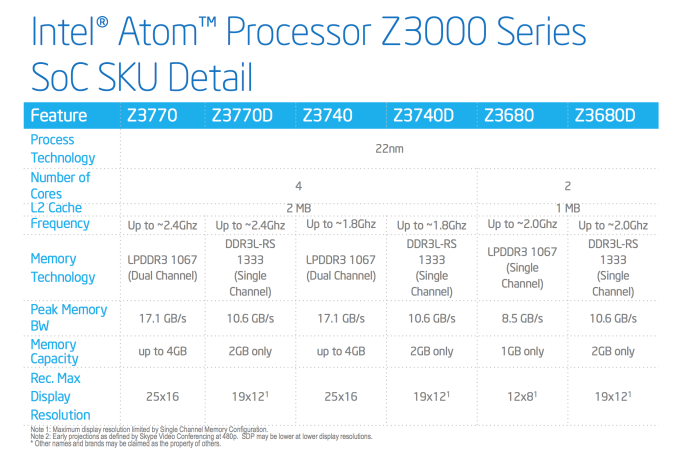
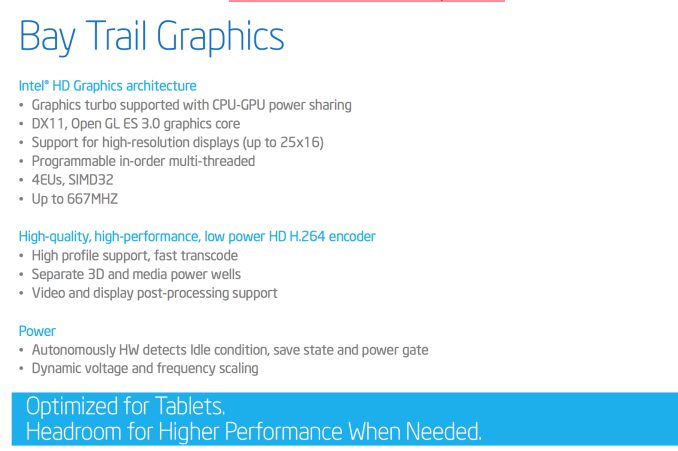
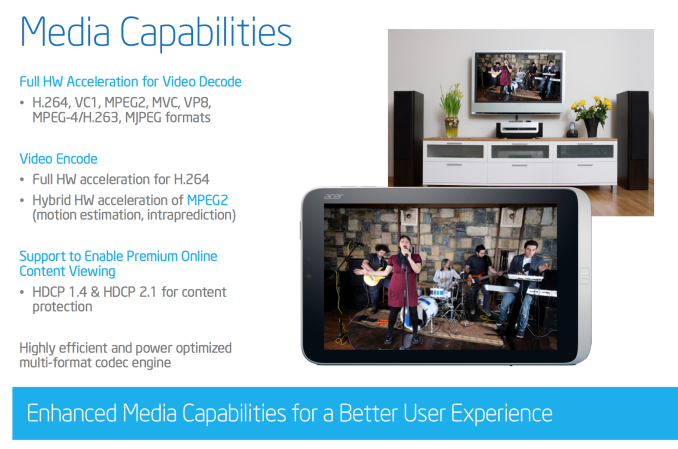








190 Comments
View All Comments
PEJUman - Wednesday, September 11, 2013 - link
NVM, some googling answers my question. Cool.. I learn something today.Kidster3001 - Thursday, September 12, 2013 - link
All of Android runs in a VM. Every Android device in the world. Apps can call native routines via JNI and some apps do contain native *.so libraries (for multiple ISA's) but in the end, Android is a VM. Your UI, your system apps, everything runs through Dalvik.The difference between Atom devices and ARM devices is that Intel has included a binary translator to convert the ARM *.so to x86 code on-the-fly. If there are no x86 .so included in the app then the x86 device will use the ARM-v7a library via the translator.
It is very easy for app developers to compile their libraries natively if they choose. Most apps have NO native libraries in them, they're all Java. When compiling a native app, just tell the system which ISAs to compile for. Of those apps which do have native components most compile for ARM, ARM-v7a and MIPS. Flicking another switch to also compile for x86 is not that difficult.
monstercameron - Friday, September 13, 2013 - link
kabini android, nope those are most likely the windows results.lmcd - Wednesday, September 11, 2013 - link
Yeah, I imagine or at least hope Kabini + HPL process is on the queue. That would make Intel work a bit harder.Nagorak - Wednesday, September 11, 2013 - link
It wouldn't be anywhere close. AMD doesn't have Intel's process advantage. If AMD could get power down by just cutting GPU performance then they probably would have done so. In a tablet power consumption is pretty damn important.In fact, more so than these load tests, idle power consumption is probably the key, and that wasn't fully tested at this point.
andrewaggb - Wednesday, September 11, 2013 - link
I kinda expected more. It should make for a decent windows 8 tablet, but given that the new iphone has 2x cpu/gpu I think it's pretty safe to say the next ipad will destroy this thing graphically.Intel needs to become a graphics leader now.... not in 2-5 years.
kyuu - Wednesday, September 11, 2013 - link
Obviously the proper comparison here would be with Temash, since that's AMD's tablet SoC. Kabini isn't meant to compete with Bay Trail in power consumption, so it's pretty far from a surprise that it draws more power.I'm guessing the results would be pretty much the same: Bay Trail beats Temash slightly in CPU benches, but still gets soundly thrashed in GPU benches.
Also, don't the current Kabini SKUs lack AMD's equivalent of turbo boosting? I thought I saw that on the Kabini review article...
silverblue - Wednesday, September 11, 2013 - link
The comparison with Kabini is an interesting one. Kabini supports more instruction sets (Bay Trail is Westmere-level which means it lacks AVX) but it has a single memory channel and lacks any form of turbo. Amusingly though, Kabini is practically on-par here in terms of single threading (per clock) but is being hampered a little in multi-threading if 7-Zip is any indication (memory bandwidth?).Add in turbo to Kabini and the Bay Trail advantage in single-threading disappears, but power usage is obviously higher. AMD have their work cut out here; Beema (and HSA) can't come soon enough.
I think AMD's yearly cadence will help here - Beema has HSA plus GCN2.0 at the very least on a more mature 28nm process - however AMD will still be on 28nm when Intel goes 14nm. Still, if HSA is the be-all-and-end-all that we've been told it is, they have hope.
The 4600M is embarrassed in CineBench; clock either SoC at 2GHz and they'll equal it for far less power. CineBench is very Intel-friendly, though the same trick in 7-Zip's multi-threaded test would result in the same outcome. Proof indeed that Kaveri is needed.
zeo - Wednesday, September 11, 2013 - link
Kabini has Turbo, only the two dual core Temash models drops it... and Bay Trail has its alternative to Turbo Boost that's called Burst technology...And HSA requires industry support... they need to make it a standard, which is why they started up the HSA Foundation, but until that happens then it's only a novelty like Nvidia's CUDA, and right now it's mainly just ARM backing them there so far...
silverblue - Thursday, September 12, 2013 - link
The only Jaguar-based chip (outside of consoles) with any turbo functionality (note I'm typing "turbo" in lower case as I'm referring to the basic technology and not a specific implementation) is, at this time, the A6-1450, which is a Temash chip. In addition, without the turbo dock, it cannot actually achieve its turbo frequencies.As regards HSA, here's something quoted from the AMD website:
"The founding members of HSA are: AMD, ARM, Imagination Technologies, MediaTek, Texas Instruments, Samsung Electronics and Qualcomm®."
Consider that ARM is what generally binds most of these together, and their huge dominance of the smartphone and tablet market, and you can easily see that HSA isn't just another "novelty like Nvidia's CUDA".
http://developer.amd.com/resources/heterogeneous-c...